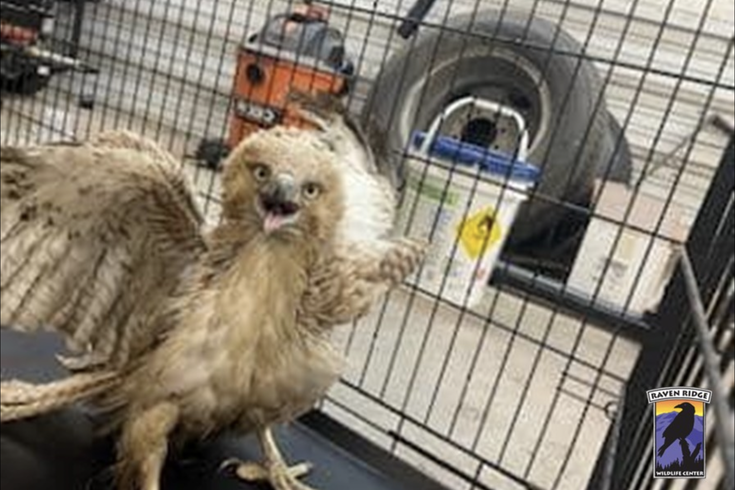
April 10, 2023
 Raven Ridge Wildlife Center/Facebook
Raven Ridge Wildlife Center/Facebook
A red-tailed hawk with the rare genetic condition leucism — causing uncharacteristically light-colored feathers — is pictured at the Raven Ridge Wildlife Center in Lancaster County, Pennsylvania. She was rescued in Franklin County last month after she was found covered in cooking oil.
Red-tailed hawks are among the most common birds of prey in North America, with an abundant population in Pennsylvania, but finding ones with feathers that aren't brown and dark red is unusual.
In Franklin County, near the Maryland border in central Pennsylvania, a red-tailed hawk with tan-colored plumage was recently found in need of help. It was covered in cooking oil that had rendered it unable to fly.
Unrelated to the hawk's predicament, it was found to have a rare genetic condition known as leucism. This results in light-colored feathers due to a lack of normal melanin production in the cells that would create the darker pigmentation typical of the species.
The Raven Ridge Wildlife Center in Lancaster County shared the female hawk's story on Facebook after it was found last month in Mercersburg. The person who found the bird initially noticed that it had remained in a low branch without moving for three days straight. The bird's light feathering initially suggested that it might have been a juvenile bald eagle.
After a few days, the person who spotted the bird safely removed it from the branch with a towel. Since it couldn't fly or even remain steady on its limbs, the hawk was kept in a cage until it could be turned over to Pennsylvania Game Commission warden Philip Bietsch, who retrieved the animal on March 25.
Bietsch was also unsure of the bird's species. He drove it to the Raven Ridge Wildlife Center to receive care.
The staff at the wildlife center determined the bird was not an eagle, but rather a red-tailed hawk with leucism. The condition is similar to albinism, but it's distinguished by several key characteristics. Albino animals do not produce any melanin at all. This causes a completely white appearance, whereas leucistic animals only have a partial loss of pigmentation that tends to create a more patchy lightness. Animals with albinism also may appear to have red eyes, but leucism does not affect eye color. The term leucism comes from the Greek word leukos, meaning "white."
More common examples of leucistic animals are some American paint horses, like piebalds, which have splotchy patches of white and black on their bodies.
An exam at the wildlife center determined that the red-tailed hawk had been covered in a cooking oil substance that had matted its feathers, preventing it from flying. It's unclear how the hawk got covered in oil. It had become hypothermic and lost some weight by the time it was brought to the wildlife center, where it was cleaned, hand-fed and rehabilitated over the last few weeks.
The wildlife center shared multiple pictures of the bird on Facebook.
"We feel that she is on the road to recovery and is making progress every day," the Raven Ridge staff said. "We are hopeful for a full recovery and to get her back into the skies once again."
Bietsch told USA Today that the bird was the first leucistic red-tailed hawk he had ever seen.
Given the large population of red-tailed hawks in the U.S., and that leucism is dependent on population size, it's likely that there's a greater incidence of the condition among red-tailed hawks than other species. The U.S. National Park Service reported another leucistic red-tailed hawk that was found injured and was rehabilitated in Georgia in 2011.
Fortunately, the red-tailed hawk found in Mercersburg appears on track to continue its life in the wild.